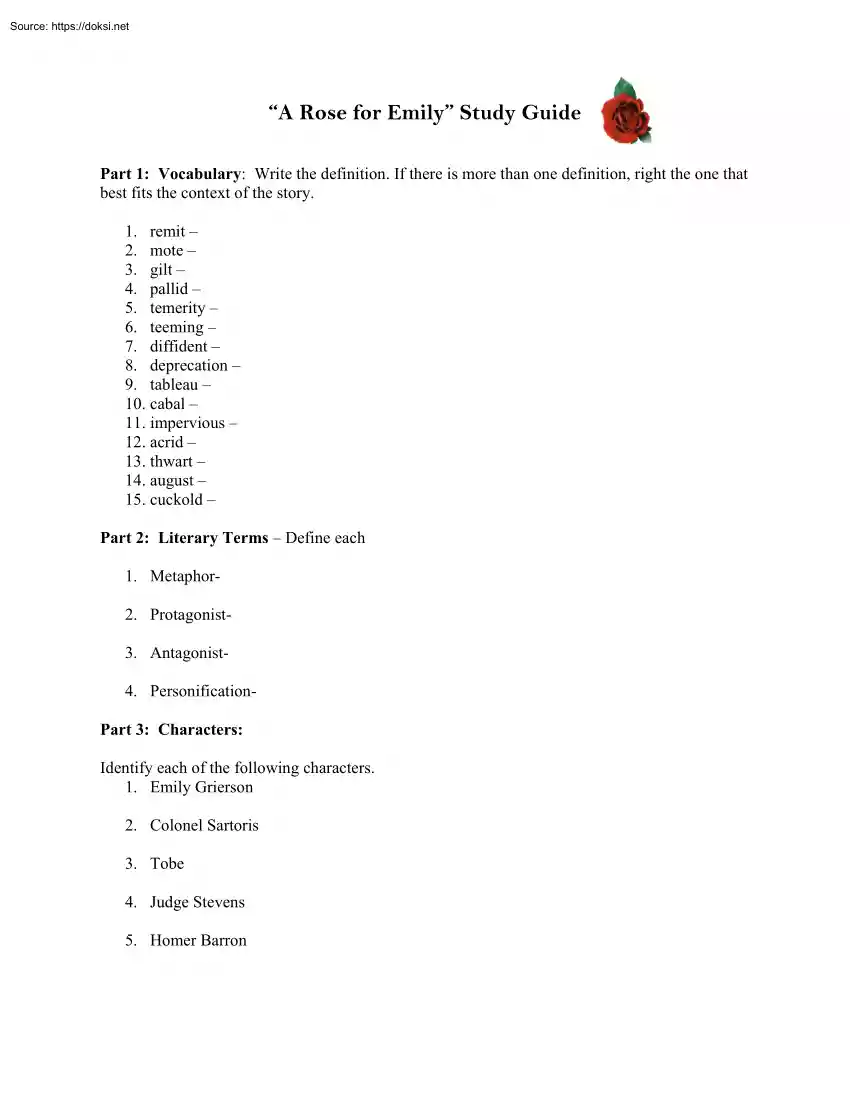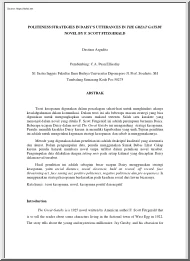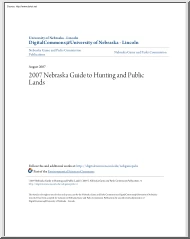Please log in to read this in our online viewer!

Please log in to read this in our online viewer!
No comments yet. You can be the first!
What did others read after this?
Content extract
“A Rose for Emily” Study Guide Main Idea Part 1: Vocabulary: Write the definition. If there is more than one definition, right the one that best fits the context of the story. 1. remit – 2. mote – 3. gilt – 4. pallid – 5. temerity – 6. teeming – 7. diffident – 8. deprecation – 9. tableau – 10. cabal – 11. impervious – 12. acrid – 13. thwart – 14. august – 15. cuckold – Part 2: Literary Terms – Define each 1. Metaphor2 Protagonist3 Antagonist4 PersonificationPart 3: Characters: Identify each of the following characters. 1. Emily Grierson 2. Colonel Sartoris 3. Tobe 4. Judge Stevens 5. Homer Barron Part 4: Reading Questions: 1. What metaphor is used to describe Miss Emily in the first paragraph? 2. How is the house personified in the second paragraph? 3. What had Colonel Sartoris done for Miss Emily in 1894? 4. What did the next generation of town leaders do on the first of the year? 5. How does Faulkner describe Miss Emily in the sixth paragraph?
6. At the beginning of Part II, how long had Miss Emily’s father been dead? 7. What are the neighbors complaining about? What does Judge Stevens say probably has caused it? 8. What did Miss Emily tell her visitors the day after her father’s death? 9. Why did the townspeople not think she was crazy for this? 10. Who began to date Miss Emily in Part III? Why was he in town? 11. What did the townspeople think of Miss Emily and her new boyfriend? 13. In Part IV, who do some of the ladies go to see about Miss Emily’s situation? Why? 14. What does Miss Emily do that makes the townspeople think that she and her boyfriend have wed? 15. Why do the townspeople believe her boyfriend/husband has left? 16. When was the last time the townspeople saw the boyfriend/husband? 17. Why had the men sprinkled the lime around her house in Part II? 18. When Miss Emily was about forty, what had she done to earn money? 19. In Part V, who returns to hold Miss Emily’s funeral? 20. There is a room
upstairs that no one has seen for forty years After Miss Emily’s funeral, the door to it is broken down. What do the townspeople find there? 21. What is noticed about the second pillow on the bed in the last paragraph? 22. What had happened to Homer Barron? Part 5: Analysis Questions 1. When you first read the story, when did you realize how it would end? What is your response to the end? 2. After you read the ending, did your view of earlier scenes change, such as the parts about about buying poison and the odor? In retrospect, where are there hints about the plot? 3. What is the conflict in this story? If Miss Emily is the protagonist, who is the antagonist (a character or force that acts against the protagonist, denying his or her desires)? 4. What people and values does the narrator represent? Does your view of the narrator affect your reception of the story? 5. In paragraphs 1 and 2, the author speaks of buildings and structures, describing Miss Emily as a fallen
monument. Where else do related images occur? If Miss Emily is a fallen monument, what is she a monument to? 6. What is the significance of sidewalks? 7. What do you think happened when the Baptist minister called on Miss Emily? Is it important that you think you understand what happened? 8. Why are we not surprised when Homer disappears? How does the storyteller ensure that we are not surprised? 9. Why do we need to know about Miss Emily's hair changing color? 10. Why did they wait until after the funeral to open the closed room? What word in the story informs you about the reasons for this delay? Is the delay consistent with the world of this story?
6. At the beginning of Part II, how long had Miss Emily’s father been dead? 7. What are the neighbors complaining about? What does Judge Stevens say probably has caused it? 8. What did Miss Emily tell her visitors the day after her father’s death? 9. Why did the townspeople not think she was crazy for this? 10. Who began to date Miss Emily in Part III? Why was he in town? 11. What did the townspeople think of Miss Emily and her new boyfriend? 13. In Part IV, who do some of the ladies go to see about Miss Emily’s situation? Why? 14. What does Miss Emily do that makes the townspeople think that she and her boyfriend have wed? 15. Why do the townspeople believe her boyfriend/husband has left? 16. When was the last time the townspeople saw the boyfriend/husband? 17. Why had the men sprinkled the lime around her house in Part II? 18. When Miss Emily was about forty, what had she done to earn money? 19. In Part V, who returns to hold Miss Emily’s funeral? 20. There is a room
upstairs that no one has seen for forty years After Miss Emily’s funeral, the door to it is broken down. What do the townspeople find there? 21. What is noticed about the second pillow on the bed in the last paragraph? 22. What had happened to Homer Barron? Part 5: Analysis Questions 1. When you first read the story, when did you realize how it would end? What is your response to the end? 2. After you read the ending, did your view of earlier scenes change, such as the parts about about buying poison and the odor? In retrospect, where are there hints about the plot? 3. What is the conflict in this story? If Miss Emily is the protagonist, who is the antagonist (a character or force that acts against the protagonist, denying his or her desires)? 4. What people and values does the narrator represent? Does your view of the narrator affect your reception of the story? 5. In paragraphs 1 and 2, the author speaks of buildings and structures, describing Miss Emily as a fallen
monument. Where else do related images occur? If Miss Emily is a fallen monument, what is she a monument to? 6. What is the significance of sidewalks? 7. What do you think happened when the Baptist minister called on Miss Emily? Is it important that you think you understand what happened? 8. Why are we not surprised when Homer disappears? How does the storyteller ensure that we are not surprised? 9. Why do we need to know about Miss Emily's hair changing color? 10. Why did they wait until after the funeral to open the closed room? What word in the story informs you about the reasons for this delay? Is the delay consistent with the world of this story?




